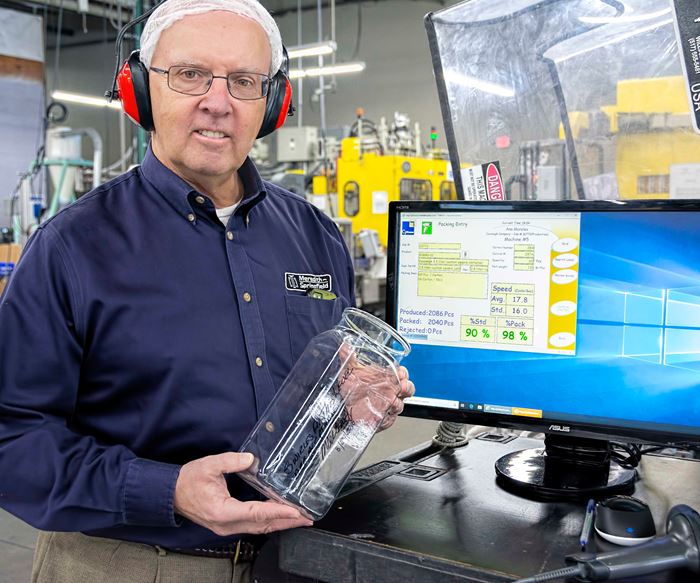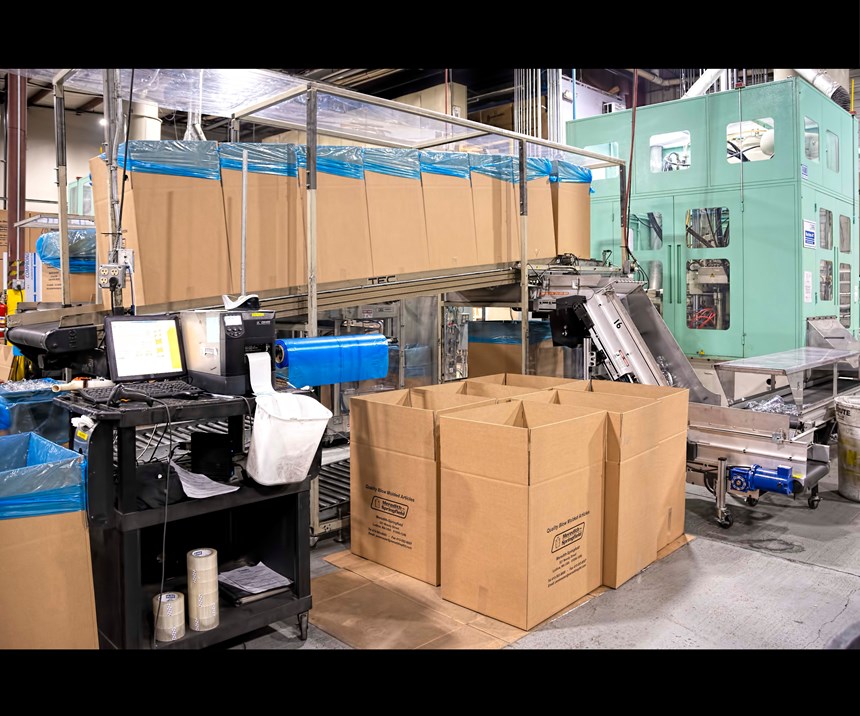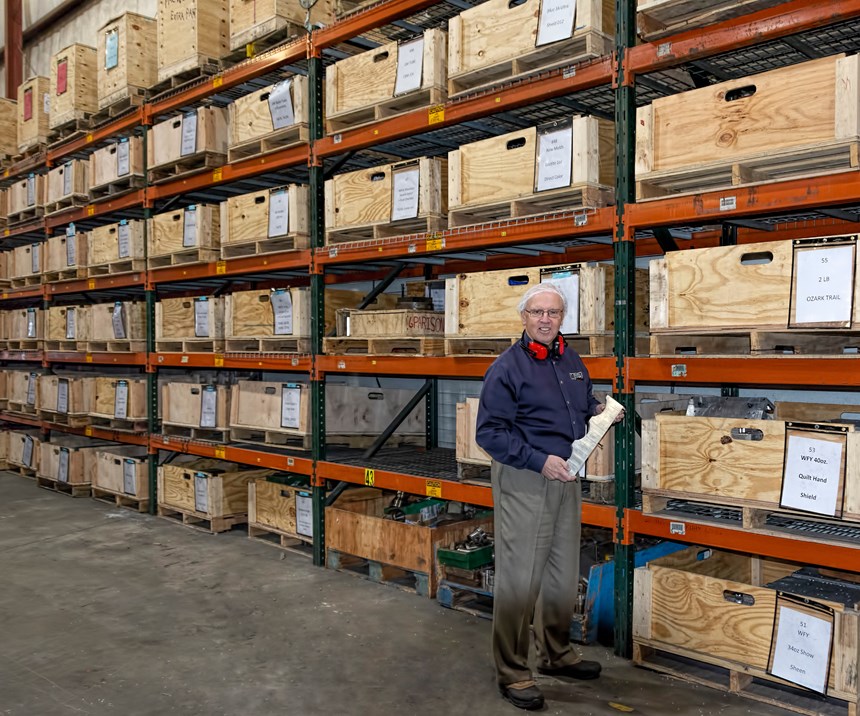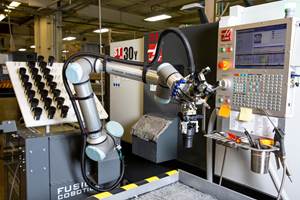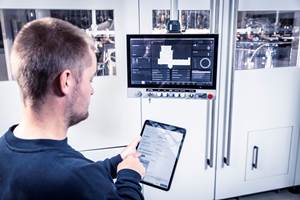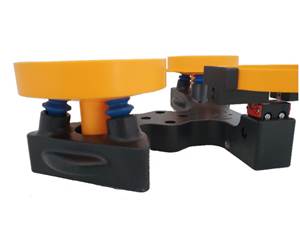Are We Having a Good Day? Real-Time Production Data Has Answers for a Custom Blow Molder
“Information automation” is one of the keys to running a successful custom blow molding business for Meredith-Springfield Associates.
“We use automation as much as possible,” says Mel O’Leary, president, CEO and co-founder of custom blow molder Meredith Springfield Associates (MSA) in Ludlow, Mass. He points to an automated box filler that indexes empty boxes into position below the end of the conveyor taking finished bottles from a blow molder. The box is shaken gently and continuously to settle the bottles as they drop in. When the box is full—determined by weight—it travels to the other end of the box filler, where an employee will attach a barcoded label and scan the label into the central plant computer. “With this auto packer, one person can tend four machines,” notes O’Leary.
But mechanical automation is not the only—or the most important—kind of automation in the plant. “We depend highly on information automation,” explains O’Leary. “Competitors can’t believe what we’re doing with information systems.”
Since 2002, MSA has used an enterprise ERP system from CyFrame that handles accounting, bills of lading, invoices, accounts receivable, general ledger, and even printing of packing slips. O’Leary says, “We were the beta site for their blow molding solution. It allows us to have only three administrative people—a small number for a company this size (100 employees, over $15 million annual revenue), and fewer than we had 18 years ago. We used to rely on Excel spreadsheets and had 10 administrative employees, and the data were never accurate or up to date. Now we get real-time data, updated every two minutes.” In addition, part-quality measurements—weight, height, wall thickness and topload strength—are sent from the QC lab to the CyFrame system, which automatically updates Cpk statistics.
Supervisors get a summary report every 4 hr. Every morning, O’Leary gets a report of the previous day’s profitability and projected theoretical profitability for the month, compared against budget. “I know every day if we’re making money or not.”
The fundamental input for this real-time data comes from machine operators on the floor. “Real-time production monitoring turns the management pyramid upside down,” observes O’Leary. Rather than monitor machine cycles and correct for rejects, MSA relies on a simple means of counting finished product. When a box of products is filled at the machine, it is sealed and a barcode label is printed, affixed to the box, and scanned by the operator. That gives MSA a measure of both finished goods and direct materials usage—resin, colorant, and packaging materials. “Tracking direct materials usage means more efficient purchasing—not too much or too little.”
He also notes that when the barcode label is scanned, the CyFrame system updates the monitor at the machine, which is color coded green, yellow and red. “This immediately tells the shop-floor staff what their efficiency is. They don’t need to wait until the end of shift or next morning.” Besides scanning each full box at the machine, pallets are scanned as they are loaded onto the truck. “Nothing moves without a barcode scan,” states O’Leary.
Large computer monitors throughout the plant display real-time efficiencies (production and setup) for every job running, as well as downtime, rejects, hours left to run on each job, and percent of the job completed. Examining one of these screens, O’Leary remarks, “We’re having a good day.”
Operating efficiency also depends on some old-fashioned paper-and-pencil methods. “We change resins, screws and heads all the time—two or three job changes a day,” says O’Leary. “So we have to be highly organized.” That includes a check sheet for every step of a job change, which forms part of a three-ring binder for each job. That binder specifies best practices and contains photos, a process data sheet, inspection sheet, and setup/changeover instructions. “Not many blow molders do this in such detail. It’s one key to our success,” O’Leary states.
Another vital element of overall efficiency is found in the tool room. There, racks hold a wooden crate for each job, containing the blow mold, trim tool, blow pins, change parts, and job-change procedure. “We keep it all in one place. No need to hunt around for all the parts needed for a job change.”
(Get the full story on why MSA is growing at double digits.)
Related Content
Beyond the Work Center: Using MES for Data-Driven Decisions Across Manufacturing Operations
Move past “is the job running” and “will it finish on time,” and apply MES to inform workflows ranging from accounting, inventory control, planning, material logistics, quality assurance, engineering and shipping.
Read MoreFour Industry 4.0 Tech Adoption Insights from Indiana Plastics Manufacturers
As more plastics manufacturers step into the Fourth Industrial Revolution, insights have emerged about how best to approach the digital transformation journey.
Read MoreAdding Remote Service Functions for PET Bottle Blowing
KHS has added features to its internet machine communications portal for PET stretch-blow molding.
Read MoreEnsuring Repeatability: The Key to Effective Injection Molding Automation
One of automation’s key promises is repeatability: the same movement to the same location, time and time again. But to achieve that, all elements involved — robot, machine, EOAT, mold — must be in and stay in alignment.
Read MoreRead Next
For PLASTICS' CEO Seaholm, NPE to Shine Light on Sustainability Successes
With advocacy, communication and sustainability as three main pillars, Seaholm leads a trade association to NPE that ‘is more active today than we have ever been.’
Read MoreSee Recyclers Close the Loop on Trade Show Production Scrap at NPE2024
A collaboration between show organizer PLASTICS, recycler CPR and size reduction experts WEIMA and Conair recovered and recycled all production scrap at NPE2024.
Read MoreLead the Conversation, Change the Conversation
Coverage of single-use plastics can be both misleading and demoralizing. Here are 10 tips for changing the perception of the plastics industry at your company and in your community.
Read More

